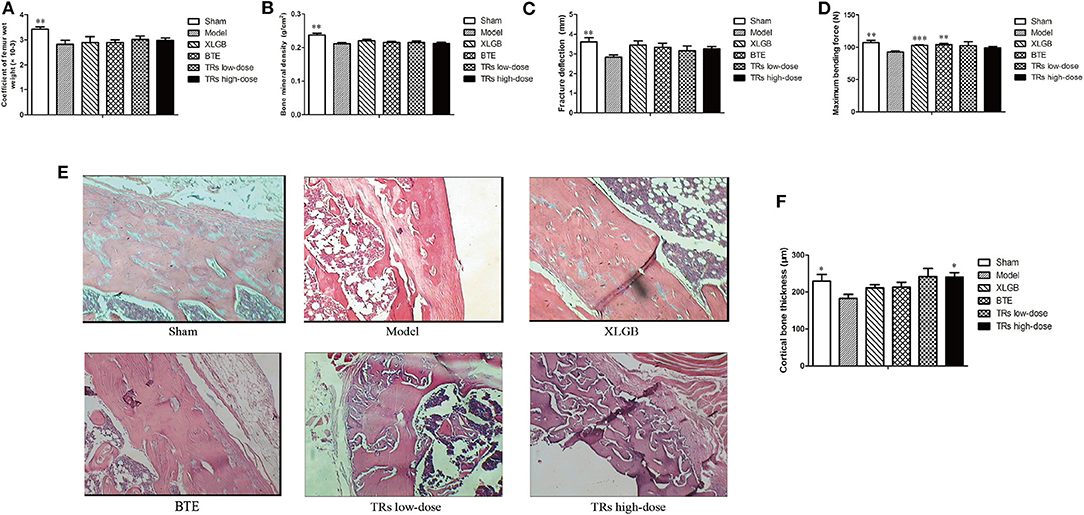Effect of Black Tea Extract and Thearubigins on Osteoporosis in Rats and Osteoclast Formation in vitro
- 1Key Laboratory of Pu-er Tea Science, Ministry of Education, Yunnan Agricultural University, Kunming, China
- 2Tea Research Center of Yunnan, Kunming, China
- 3College of Food Science and Technology, Yunnan Agricultural University, Kunming, China
- 4College of Science, Yunnan Agricultural University, Kunming, China
- 5State Key Laboratory for Conservation and Utilization of Bio-Resources in Yunnan, Kunming, China
A Corrigendum on
Effect of Black Tea Extract and Thearubigins on Osteoporosis in Rats and Osteoclast Formation in vitro
by Liang, Q., Lv, M., Zhang, X., Hu, J., Wu, Y., Huang, Y., et al. (2018). Front. Physiol. 9:1225. doi: 10.3389/fphys.2018.01225
In the original article, there was a mistake in Figure 2 as published. Panels 2 and 3 (cortical bone tissue stained with H&E for Model and XLGB group, respectively) of Figure 2E in this paper are the same images as panels 2 and 3 of Figure 4D in Wang et al. (2018). Based on the 3R (Reduction, Replacement, and Refinement) principle of experimental animals, the authors simultaneously and systematically evaluated the pharmacological effects of Dendrobium officinale Orchid extract, black tea extract, and thearubigins in preventing osteoporosis using the same batch of ovariectomized (OVX) female rats as animal model of postmenopausal osteoporosis in the animal experiment study. They then collected the data and published two articles mentioned and this is how this error was introduced. The corrected Figure 2 appears below.

Figure 2. The effect of black tea extract (BTE) and thearubigins (TRs) on bone quality in ovariectomized (OVX) rats. (A) Femur wet weight coefficient, (B) bone mineral density, (C) femoral fracture deflection, (D) maximum bending force for each treatment group. (E) The cortical bone tissue was examined by hematoxylin and eosin (H&E) staining (magnification × 400) and (F) cortical bone thickness counts, statistical analysis. All data are presented as mean ± SEM (n = 10). “Independent Samples T-Test” and “One way ANOVA” were used for the comparison of sham vs model group and model vs treatment groups using pooled variance, respectively. *p < 0.05, **p < 0.01, and ***p < 0.001 vs model group.
The authors apologize for this error and state that this does not change the scientific conclusions of the article in any way. The original article has been updated.
References
Keywords: osteoporosis, black tea extract, thearubigins, osteoclast, osteoclastogenesis
Citation: Liang Q, Lv M, Zhang X, Hu J, Wu Y, Huang Y, Wang X and Sheng J (2020) Corrigendum: Effect of Black Tea Extract and Thearubigins on Osteoporosis in Rats and Osteoclast Formation in vitro. Front. Physiol. 11:136. doi: 10.3389/fphys.2020.00136
Received: 10 January 2020; Accepted: 07 February 2020;
Published: 25 February 2020.
Edited and reviewed by: Geoffrey A. Head, Baker Heart and Diabetes Institute, Australia
Copyright © 2020 Liang, Lv, Zhang, Hu, Wu, Huang, Wang and Sheng. This is an open-access article distributed under the terms of the Creative Commons Attribution License (CC BY). The use, distribution or reproduction in other forums is permitted, provided the original author(s) and the copyright owner(s) are credited and that the original publication in this journal is cited, in accordance with accepted academic practice. No use, distribution or reproduction is permitted which does not comply with these terms.
*Correspondence: Yewei Huang, lichuangyewei100@163.com; Xuanjun Wang, wangxuanjun@gmail.com; Jun Sheng, shengj@ynau.edu.cn
 Qingqing Liang
Qingqing Liang Ming Lv
Ming Lv Xiaojuan Zhang1,2,3
Xiaojuan Zhang1,2,3 Jun Hu
Jun Hu Ying Wu
Ying Wu Yewei Huang
Yewei Huang Xuanjun Wang
Xuanjun Wang Jun Sheng
Jun Sheng